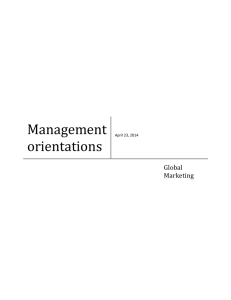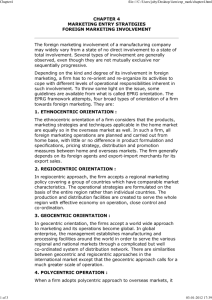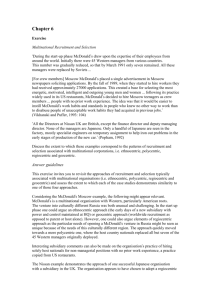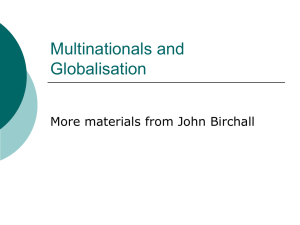Nature of International Marketing
advertisement
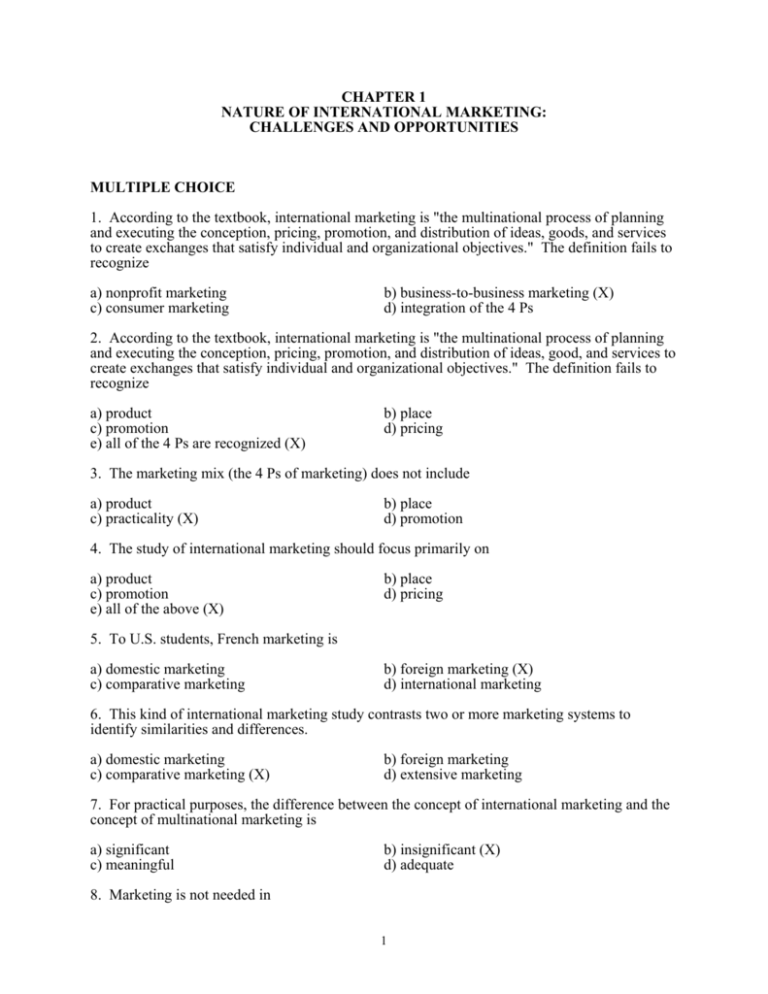
CHAPTER 1 NATURE OF INTERNATIONAL MARKETING: CHALLENGES AND OPPORTUNITIES MULTIPLE CHOICE 1. According to the textbook, international marketing is "the multinational process of planning and executing the conception, pricing, promotion, and distribution of ideas, goods, and services to create exchanges that satisfy individual and organizational objectives." The definition fails to recognize a) nonprofit marketing c) consumer marketing b) business-to-business marketing (X) d) integration of the 4 Ps 2. According to the textbook, international marketing is "the multinational process of planning and executing the conception, pricing, promotion, and distribution of ideas, good, and services to create exchanges that satisfy individual and organizational objectives." The definition fails to recognize a) product c) promotion e) all of the 4 Ps are recognized (X) b) place d) pricing 3. The marketing mix (the 4 Ps of marketing) does not include a) product c) practicality (X) b) place d) promotion 4. The study of international marketing should focus primarily on a) product c) promotion e) all of the above (X) b) place d) pricing 5. To U.S. students, French marketing is a) domestic marketing c) comparative marketing b) foreign marketing (X) d) international marketing 6. This kind of international marketing study contrasts two or more marketing systems to identify similarities and differences. a) domestic marketing c) comparative marketing (X) b) foreign marketing d) extensive marketing 7. For practical purposes, the difference between the concept of international marketing and the concept of multinational marketing is a) significant c) meaningful b) insignificant (X) d) adequate 8. Marketing is not needed in 1 a) socialist countries c) less developed countries e) marketing is needed in all countries (X) b) communist countries d) developed countries 9. MNCs are often associated with a) exploitation c) power e) all of the above (X) b) ruthlessness d) bigness 10. Midsize German companies' contribution to Germany's export success is a) significant (X) c) uneven b) minor d) unpredictable 11. This definition of MNC focuses on the number of countries in which the firm does business and the citizenship of corporate owners and top management. a) structure (X) c) behavior b) performance 12. This definition of MNC depends on the contribution of foreign operations in terms of earnings, sales, and assets. a) structure c) behavior b) performance (X) 13. A strong orientation toward the home country is an indication of a) ethnocentricity (X) c) geocentricity b) polycentricity 14. This is the feeling within a culture that its values are superior to those of foreign cultures. a) ethnocentricity (X) c) geocentricity b) polycentricity 15. When a firm uses the same marketing strategies abroad as that used at home, it probably is a) ethnocentric (X) c) geocentric b) polycentric d) unicentric 16. When a U.S. firm leaves local managers of its foreign subsidiary alone by assuming that the foreign market is difficult for outsiders to understand, this is a reflection of a) ethnocentricity c) geocentricity b) polycentricity (X) 17. Decentralization is likely in the case of a) ethnocentricity c) geocentricity b) polycentricity (X) 2 18. This kind of orientation often results in duplication of effort among overseas subsidiaries. a) ethnocentricity c) geocentricity b) polycentricity (X) 19. When companies believe that, even though countries may differ, the differences can be understood and managed, such firms are a) ethnocentric c) U.S.-centric b) polycentric d) geocentric (X) 20. These firms allocate corporate resources without regard to national frontiers and do not hesitate making direct investment abroad. a) ethnocentric firms c) geocentric firms (X) b) polycentric firms 21. Beatrice Foods may want to give up its U.S. citizenship because of tax advantages abroad. This kind of thinking is a) ethnocentric c) geocentric (X) b) polycentric 22. This kind of company does not identify itself with a particular country and may even prefer to lose its national identity. a) ethnocentric c) geocentric (X) b) polycentric 23. Firms that combine aspects of centralization and decentralization are a) ethnocentric c) geocentric (X) b) polycentric 24. Because of trade (and imports), inflation a) increases c) moderates (X) b) decreases d) disappears 25. As a result of international trade and global interdependence, countries' inflation rates tend to a) increase c) be unpredictable b) moderate (X) d) be unstable TRUE OR FALSE 1. Marketing is the process that encourages and facilitates an exchange between two parties. (T) 3 2. Because international marketing requires that a product is exported (moved), place (distribution) is thus more important than the other 3 Ps of the marketing mix. (F) 3. Because of the distance between markets, place (distribution) was and is still the primary focus of the study of international marketing. (F) 4. For practical purposes, any subtle difference between the concept of international marketing and the concept of multinational marketing is insignificant. (T) 5. From business firms’ perspective, multinational marketing and international marketing are essentially the same thing. (T) 6. The distinction between international marketing and multinational marketing is insignificant in practice. (T) 7. Domestic marketing and international marketing are similar in nature but not in scope. (F) 8. Domestic marketing and international marketing, while differing in scope, are similar in nature. (F) 9. International marketing is domestic marketing on a larger scale. (F) 10. The degree of overlap of the countries' sets of uncontrollable variables will dictate the extent to which the 4 Ps must change. (T) 11. Marketing is a universal activity. (T) 12. Marketing principles are applicable in certain countries only. (F) 13. Since marketing is a universal activity, consumers in all parts of the world can be satisfied in exactly the same way. (F) 14. Universal marketing principles imply the applicability of a uniform marketing mix for all markets. (F) 15. Marketing principles are likely to be more universal than marketing strategies (i.e., marketing mix). (T) 16. Marketing principles theories are probably universal, but marketing strategies (marketing mix) are not. (T) 17. Although marketing principles are generally universal, the marketing strategies derived from such principles are not necessarily so. (T) 18. When a certain marketing principle is universal, the marketing mix derived from it that is employed successfully in the United States will also be universally effective when this marketing mix is applied to the non-U.S. markets. (F) 19. China and Russia do not need marketing. (F) 20. Marketing is not needed in less developed countries. (F) 21. MNCs are often associated with exploitation and ruthlessness. (T) 4 22. Evidence shows that globalization encourages location of polluting industries in countries with low environmental regulations. (F) 23. MNCs create social benefits by facilitating economic balance. (T) 24. MNCs facilitate economic balance by serving as an efficient instrument of effective production and distribution of goods and services. (T) 25. MNCs act as an instrument to efficiently utilize the world's resources. (T) 26. In order to be an MNC, a company must be big (i.e., MNC is a function of size). (F) 27. The relationship between a firm's degree of multinationality and its market performance is linear and positive. (F) 28. The relationship between a firm's degree of multinationality and its market performance is curvilinear. (T) 29. For a firm to operate internationally and successfully, its corporate size matters--but only up to a certain extent. (T) 30. Compared to large German corporations, midsize German companies do not contribute significantly to Germany's export success. (F) 31. Japanese multinationals have been reluctant to commit their corporate resources to overseas assets. (F) 32. Ethnocentricity and centralization tend to be related. (T) 33. A strong orientation to the host country is known as geocentricity. (F) 34. Polycentricity usually results in uniform marketing. (F) 35. A geocentric firm does not identify itself with a particular country. (T) 36. A company is polycentric when it thinks internationally. (F) 37. Geocentric firms combine aspects of centralization and decentralization. (T) 38. There is evidence that geocentricity and companies' international practices (e.g., international trade propensity) are related. (T) 39. Being international (multinational) is a matter of degree. (T) 40. Being international is an absolute rather than a matter of degree. (F) 41. MNC is a one-dimensional concept. (F) 42. Internationalization is a one-dimensional concept. (F) 5 43. It is reasonably reliable to employ a single-variable measure to characterize the internationalization concept. (F) 44. There is no empirical evidence to support a hypothesis that some firms are “born global” in the sense that their mission from the outset is to become multinationals. (T) 45. Foreign markets allow a firm to diversify its risk posed by cyclical/seasonal factors. (T) 46. International trade minimizes the problem of inflation. (T) 47. International trade tends to create inflationary pressures. (F) 48. Import quotas depress price competition and ignite inflation. (T) 49. International marketing is a subset or special case of domestic marketing. (F) 50. The value of international marketing is not so much that it helps us to understand people abroad but rather that it helps us to understand ourselves more. (T) 6

